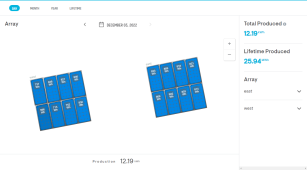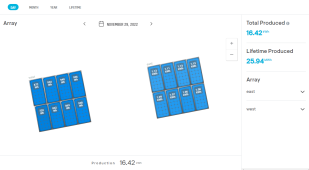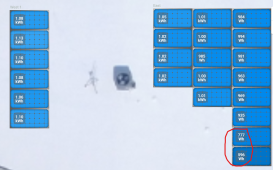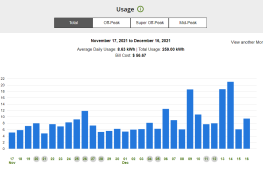From the morning to about 2 pm, shadows are not a problem here. This is the array view today, at 1:44 PM

The very bottom left corner is just starting to get the shadows from the palm trees. Here is the entire day from Nov. 29, the last decent production day before the storm came through.

If you compare the two plots, you will notice that the lower roof, especially the far bottom left corner, does not get all the much more energy after 2 pm, while the upper roof on the right side pulls in another 300 watt hours per panel. By 4 pm, basically the entire lower roof is in shadow. If I totally chopped down the last of my palm trees, it will help a little, but only in the dead of winter with the very low sun angle. And the local tree guys want over $1,000 per tree to take them down, and it is 4 more trees. Ouch. In the summer, when I need more power to run the A/C, I don't get any shade issues from those trees.
Too bad I don't get anywhere near this kind of information from the DC array. But I have manually watched it a few days by checking it from time to time and it does give the total energy and peak power for each day. Again, in the dead of winter with the low sun angle, the DC array on the garage is getting a morning shadow from my neighbor's palm trees. But this is only in the very early morning, and it clears by about 9:30 am. And the DC panels still make more sun hours in that time than the Enphase array. At the same time, the entire lower roof is still shaded by the second floor of the house. The sun does not fully hit the lower roof array until 10 am or so.
The bad part about the DC array is that I am running series strings. Currently it is 2 parallel strings of 5 panels each in series. I did a little experiment, and just the shadow of my arm over one panel drops the DC array output by over 40%. And if I put that shadow on both rows, the output is 70% less than with no shadows. It's a good thing that the DC array has virtually no shadow from 9 am to 5 pm, even with the low winter sun. In summer, it should be shadow free from 8 am to 6 pm.
After the last 2 days of lousy production, it is so nice to have sun again. It is now 2 pm. The Enphase/SilFab array has already produced 12.2 KWHs, and the BourgeRV/NewPowa array has produced 2.22 KWHs. Already, the DC array alone has made more energy than the whole system did all day on Dec. 1. The lower roof of the Enphase system is now getting shadows and the output has dropped to 1,340 watts (28% of rated power), while the much smaller DC array without shadows is still putting out about 450 watts (45% of rated power). Looking at each panel shows what is going on here.

The shaded panels are down to just 10 to 12 watts while the panels that are getting full sun are still making 148 to 159 watts even with the low sun angle. So the panels getting full sun are still doing better than the DC array. And you will notice it is 8 panels making good power and 8 panels not doing well. That is the upper vs lower roof. Putting the panels 10 feet higher gets them out of the shadows. from the low evening winter sun.








